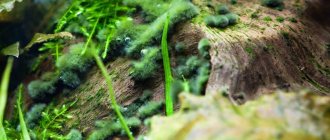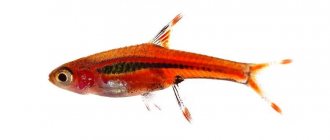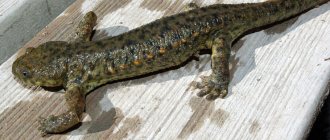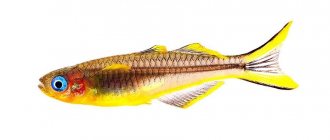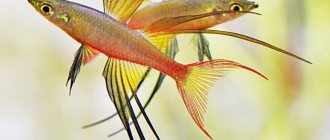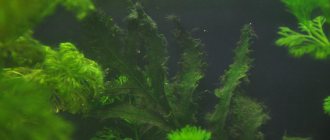Pogostemon erectus is a popular aquarium plant, with the help of which the most ordinary body of water can be transformed into an unusually beautiful underwater kingdom. The plant belongs to the department of angiosperms, the class of dicotyledons, the order of Lamiaceae, the family of Lamiaceae, and the genus Pogostemon.
Under natural conditions, Pogostemon grows in India. Here he chose slow-flowing rivers and closed reservoirs with fresh or slightly brackish water. Prefers coastal areas or shallow waters of lakes and ponds, where it receives a lot of heat and sunlight.
Description
The name Pogostemon erectus comes from the Latin term erectus - “straightened”. This plant has a long, straight stem up to 40 cm high with densely planted thin, sharp leaves resembling the needles of a young spruce.
INTERESTING: The thickness of the leaves and the intensity of their color depend on the conditions of the plant. With regular feeding, the leaves retain a rich green color; in dim light they turn pale, and in intense light they acquire a light purple tint.
Erectus grows slowly. Due to its long stems, it is most often used for background landscaping, or planted along the side walls of the aquarium. Thin, graceful needles of Pogostemon go well with purple aquarium plants.
Return to content
Pogostemon erectus
Pogostemon erectus photo
Pogostemon erectus is a beautiful long-stemmed plant that has recently become very popular. This plant looks like a Christmas tree, which looks attractive in the background of the aquarium.
Pogostemon erectus has eight long and thin leaves in a whorl (length ~ 4 cm, width ~ 1 mm). The internode is short ~ 5 mm. Five branches of Pogostemon erectus in one or two months can form a lush, magnificent group in the background.
The plant's growth rate is average. In an aquarium with a high light intensity of 70 Lm/L, this plant is usually trimmed once every two weeks. It is better to cut the stems selectively, thinning out the group, thereby giving young shoots access to light. This haircut allows you to maintain consistently beautiful and lush thickets of pogostemon.
Pogostemon erectus photo
Water parameters for keeping Pogostemon erectus : temperature 22-27 ° C, kH 2-7 °, dH 6-8, pH 6.5-8. The plant does not like cloudy water, so proper mechanical filtration, water changes and aeration are required.
Pogostemon erectus is unpretentious regarding the presence of fertilizers in water. Unlike many similar lush plants, Pogostemon erectus easily adapts to conditions of lack of nutrition and does not stop actively branching, forming dense thickets.
With the proper concentration of NO3 in water, it has lush green leaves. It is better to grow this plant in an aquarium with at least a minimal supply of CO2, a minimum concentration of 5 mg/l. It grows better in soft water, but does not disappear in hard water.
Pogostemon erectus photo
When decorating an aquarium, it is better to place Pogostemon erectus in the background, but given its ability to quickly form lush groups of even small heights, it can also look good in the middle ground. This plant attracts the viewer's attention with its splendor and rich color, so it is better to place it near the golden ratio.
Pogostemon erectus reproduces vegetatively. Cut off the side shoot and replant it in the ground. Soon it will take root and begin to grow.
Pogostemon erectus photo
Cool videos about plants from FanFishki
Subscribe to our YouTube channel so you don't miss anything
PRACTICAL NOTE ON GROWING AQUARIUM PLANTS
This note is posted in all FanFishka articles dedicated to aquarium plants. This is a cheat sheet with a link that will help you grow any aquarium plant and herbalist of any complexity.
Most of the reference materials are located in the Aquascape , we also recommend our brochure: Aquarium navigator for beginners: “Underwater Gardens of Babylon” .
The formula for success in growing plants can be depicted as follows.
First of all, the proper level of lighting is necessary.
(light intensity - Lumens)
Next, the proper concentration of CO2
Further macro-fertilizers and micro-fertilizers
Water parameters, care and quality water changes
The gradation of this formula is based on the degree of importance. Lighting intensity is primary, and then descending. Therefore, if your plants have holes in the leaves, they have sciatica (crooked) or there are problems with algae, then please do not read the “bad advice” - this is chlorosis (lack of iron), this is a lack of potassium... diarrhea, phimosis and endometriosis )
You always need to solve the problem of setting up an herbalist from major to minor. Plants will die more quickly from a lack of lighting than from a lack of Fe and K. Moreover, the latter are always present in one degree or another in the aquarium, but it is difficult to measure their precise value.
Below, let's go from the main to the minor.
Lighting in an aquarium with plants . Remember, the most important thing in light is its intensity (Lumens)! All other lighting characteristics: spectrum, Kelvin, PAR/PAR, Ra... are important, but secondary. There will be no intensity of lighting, there will be nothing. At the same time, the lighting intensity must be balanced - selected specifically for your project (height of the water column, number and types of plants, daylight hours).
Based on the above, choose aquarium lighting primarily by the number of lumens, and then everything else.
Lighting is the most expensive part. The most budget-friendly solution is to install ordinary construction-street floodlights above the aquarium . Fortunately, they are now very thin and aesthetic. And believe me, under them everything grows with a bang, of course, provided that all the other components are present.
In order not to be unfounded, here are photos of our herbalists, which were grown exclusively under LED spotlights or with their presence.
If you want professional lighting or aesthetics. Then you will have to fork out some money. The amounts can vary quickly from 10,000 to 50,000+ rubles for a 100 liter aquarium. For example, in 2021 we switched to professional lighting - ISTA Titan . Yes, not cheap, but the lamps are Achon! We have grown a professional competitive aquascape under them. That’s why we advise you to pay attention to them.
Well, it’s difficult to advise anything, because... Everyone has different needs and capabilities. In this article we talk about the products of our partners - Tetra , Laguna , ISTA lighting .
We tried to briefly and objectively talk about them. Then it's up to you. In any case, we do not really recommend that you pay attention to handicraft lighting assembly from folk craftsmen. Not all, but as a rule, they shove who knows what kind of diodes into such an assembly, assemble it all on their knees... and believe me, more than once on the forum you hear echoes of the consequences of such a purchase. After all, a company is a company. At a minimum, you are given warranty and post-warranty service.
If you are a beginner, your first herbalist, then LED spotlights are your choice. Let's move on, otherwise this note isn't very short =)
CO2 for aquarium plants . The plant is approximately 90% water, the remaining 10% is dry matter. Of that 10%, 46% is carbon. This is why CO2 supply is so important in a planted aquarium.
Plants in an aquarium obtain carbon “from water” - from carbon-containing compounds. But the natural concentration of C-carbon in water is small and is only sufficient for unpretentious plants, but they, and even more so, will be happy with additional carbon feeding. The supply of CO2 can be provided using mash or a CO2 balloon system , lemon juice or other methods.
The best, professional, simple and budget option is to supply carbon dioxide through a cylinder. One thing, however, is the initial purchase of a set: a cylinder, an MG valve, a diffuser…. will hit the budget.
Is it possible to do without CO2, but for a couple of bushes of simple plants ( cryptocorynes , echinodorus , most ludwigias , etc.).
What balloon systems can you recommend? The most budget option is an assembly from craftsmen who sell CO2 systems in VK and on forums. Everything is very high quality.
If you want a branded item, then we recommend the most inexpensive and at the same time high-quality CO2 systems from ISTA (Taiwan) . We have been using them for 5 years and recommend them to you.
On sale you will find two series of ISTA Aluminum CO2 Cylinder cylinders, with horizontal and vertical threads of 1 and 3 liters.
Fertilizers for an aquarium with plants . All fertilizers, of any brand, can be divided into MACRO-FERTILIZERS and MICRO-FERTILIZERS .
Macro fertilizers are nitrate NO3 and phosphate PO4 from which plants take N-nitrogen and P-phosphorus. These are the most important elements after CO2 - C-carbon.
Remember - Redfield's proportion rules . Always keep it under control and everything will be ok. Right, based on our observations, Redfield’s proportion rules only in full NPC proportions. Incomplete proportion - without carbon C does not give good results.
Micro fertilizers . These are all the other less important elements that are necessary for plants (see link). There is no point in putting too much emphasis on them. Firstly, all of them are contained in one quantity or another in tap water and are restored in the aquarium with changes. Secondly, an overdose of micro very quickly leads to an outbreak of algae.
A common mistake made by beginners is not understanding what they are pouring into the aquarium. For example, let's take such a popular and popular fertilizer as Tetra PlantaMin . Read the product summary at the link - it strengthens, stimulates, and gives a chic body shape.
A beginner, without delving into the essence, uses it and gets an outbreak of algae, writes on the forums - “Like, wow, what a bad Tetra.” And the trouble lies not in the drug, but in a lack of understanding of the nitrogen cycle and balance in the herbalist . The beginner has a Redfield bias (let’s say N and P are generally zero) and instead of making up for the lack of these primary elements, he fills the aquarium with Tetra PlantaMin - a micro-fertilizer (iron, potassium, manganese). As a result, going over the micro is only detrimental, because... plants lack the base - nitrogen and phosphorus.
Thus, you must understand what plants lack and understand fertilizers.
How to understand what plants lack? It's simple. Now the market is filled with a variety of expensive and not so expensive aquarium water tests. We recommend inexpensive domestic ones - VladOx drop tests , they are sold online and offline.
We also recommend, let’s not be afraid of this word, innovative domestic UHE tests . They are currently only sold online.
The minimum set of tests for an herbalist is NO3 and PO4. It is advisable to have the entire nitrogen range: NH4, NO2, NO3. As well as kH and pH tests.
Tests help us monitor the situation in the herbalist, but over time it is advisable to learn to see and feel the aquarium for yourself. With experience you need to move away from “convulsive testing”; the best aquarium test and tool is ourselves.
Let's summarize this part. Macro, it’s macro in Africa too. The link above generally contains a recipe on how to make them yourself. If you are not yet ready for self-mixing, then always and everywhere you will find a line of fertilizers from Tetra: Tetra Planta Macro , Tetra PlantaMicro , substrates, root tablets and much more .
Of course, there are many other brands that produce aquarium fertilizers. There is an opportunity, use even ADA products. All markers are different in taste and color. The main thing is to use it with a clear understanding of what you are using it for and what you want to get in the end.
From the professional line of fertilizers, at an adequate price, we can recommend Prodibo (soils, soils, macro, micro, stimulants, etc.).
So, something like a note turns into the Talmud. Which is not surprising - the topic is very broad. One moment left.
Water parameters for aquarium plants. Link1 and Link2 , please look at these articles, they cover the essence quite well.
Here we note that the quality of photosynthesis is influenced by the process of caring for the aquarium: water parameters (kH, pH below 7), high-quality filtration and aeration, competent and timely water changes.
Please study
Conditions of detention
Pogostemon erecta loves warm, well-lit ponds with clean water. The optimal conditions for its maintenance are listed in the following table.
| Conditions for keeping Pogostemon erectus | |
| Indicators | Indicator values |
| Soil thickness, cm | 6-7 |
| Lighting intensity, W/l | 0,7-1,0 |
| Carbon dioxide supply, mg/l | 8-12 |
| Water temperature, ◦С | 20-28 |
| Rigidity | Up to 20 |
| Acidity | 5,5-6,0 |
| Water change | Weekly up to 30% of volume |
Pogostemon erecta is a light-loving plant that should be planted in open, well-lit areas of the ground. As the emerald herringbone grows, it is necessary to ensure that it is not shaded by other plants.
Return to content
Planting and care
Pogostemon octopus should be planted in bunches in the aquarium in the background; it will organically fit into the overall design and focus attention on the beauty of all the vegetation. The bush grows slowly. Octopus stems are soft and fragile, so most herbivorous fish can feed on them.
Such a demanding plant needs special care: the temperature should be 26 degrees, the acidity pH should be up to 7.5, and you also need to regularly replace a quarter of the water in the aquarium with new water weekly. The lighting brightness should be no more than 1.0 W/l, and the duration of the lighting period should be up to 12 hours a day. You should also ensure that the octopus does not become overgrown with algae - this will spoil the appearance of the vegetation itself and lead to its death.
If the methods of keeping it are not suitable for Pogostemon octopus, it will immediately give a signal - its leaves will change color, so it will be possible to take action in time.
The aquarium soil should be silted, sandy or gravel. It needs regular feeding with macro and micro fertilizers. If water parameters change, Pogostemon Octopus will immediately respond to such changes.
Octopus plants take a long time to adapt to a new aquarium, so they need to be planted in an aquarium that has already been working for a certain time for better survival. It is also recommended to keep non-herbivorous fish with pogostemon so that the stems remain green and beautiful.
Pogostemon octopus bushes are planted in soil, which is rich in nutrients, at a short distance from each other in several bunches. If you plant them close, then after a while the lower leaves will begin to die off due to lack of light.
The adaptation period is up to one month. During this period of time, the plant can shed all its leaves and stop its growth. If Octopus is placed in a newly purchased aquarium, it will quickly die in the new soil.
Plant care
Pogostemon erectus is characterized by medium complexity of maintenance. For it, it is necessary to organize sufficient lighting, good filtration, regularly change the water, feed it with complex fertilizers and sometimes cut it, giving the bush the desired shape.
A haircut
To maintain compact group sizes, some aquarists regularly trim thickets of Pogostemon erectus, cutting off too long stems by about a third. Some time after cutting, the plant begins to produce side shoots. As a result, the bush takes on a more decorative appearance, becomes lush and compact.
Top dressing
Pogostemon erectus should be regularly fed with liquid fertilizers containing nitrogen. By receiving important trace elements and minerals from the aquatic environment, the plant becomes stronger and more actively forms side shoots. You can also bury small pieces of clay in the soil to feed the plant.
Filtration
Successful breeding of Pogostemon erectus requires filtration and regular water changes. In an aquarium without a filter, the leaves and stems of the fluffy Christmas tree become covered with a slippery coating, which impedes the plant’s gas exchange. Every 10-15 days, 10-30% of the water in the aquarium should be replaced, this will keep the aquatic environment clean and fresh.
Return to content
Appearance
It has 8 leaflets in a whorl of a very elongated shape - approximately 4x1 mm. The shoots are erect, the color is green with a slight purple tint. It grows at an average speed, is unpretentious in terms of fertilizers, but does not tolerate muddy water well. Looks great in the background of a man-made underwater landscape or in its center, as a spectacular decoration for its inhabitants. Forms bright and attractive combinations with red and purple aquatic grasses.
Photo gallery of Pogostemon Erectus:
Reproduction
Pogostemon erecta reproduces with the help of lateral shoots, which quickly take root and painlessly adapt to a new location. To propagate this aquarium plant you need:
- select a strong lateral shoot and separate it from the bush using scissors;
- choose a well-lit place for planting, dig a small hole in the ground and place the shoot in it;
- fill the hole with soil without compacting it.
REFERENCE: Pogostemon erectus has a strong root, so it requires a layer of soil at least 6-7 cm thick. Small quartz, pebbles, coarse sand or river gravel, taken separately or mixed together, are suitable as a substrate.
Return to content
Pogostemon octopus - aquarium plant
Pogostemon octopus (from the English pogostemon octopus) is the most common plant in the waters of Australia and Southeast Asia, which was brought to our region from there. Pogostemon octopus began to be closely propagated relatively recently - just over 10 years ago, but even now this species is the most common decoration of modern aquariums. However, it is worth noting that the plant is quite finicky and requires proper care and maintenance, so it is recommended that only knowledgeable and competent aquarists keep it.
The plant Pogostemon octopus is formed in the form of long narrow green leaves. It received the name “octopus”, which translates as “octopus”, not by chance. The leaves cannot stay still when planted close to an aquarium filter; they move like octopus tentacles. When approaching the light, the tops of the octopus acquire a red-brown color. The length of an adult plant can reach 60 centimeters and the width – 25 centimeters. Despite its considerable size, Pogostemon octopus does not interfere with the development of other types of vegetation, since its thin stems do not create much shade.
Compatibility with other aquarium inhabitants
Pogostemon erectus is a lush green bush whose delicate leaves are loved by snails and herbivorous fish. For this reason, aquariums with herbivorous inhabitants in which they live are not suitable:
- any snails;
- guppy;
- platies;
- mollies;
- barbs;
- cichlids;
- Clarius catfish.
But in the company of shrimp, goldfish, tetras, predatory catfish, labyrinth fish and neons, this aquarium plant will feel safe.
If you follow the conditions for keeping erectus, it will live in an aquarium for 2 to 4 years and will delight its owner with good health and juicy, lush, bright green bushes, similar to a young spruce forest in miniature.
Return to content
Diseases
Pogostemon diseases are mainly associated with deterioration of breeding conditions and are easily recognized by a simple description. Let's look at the most common ones.
- Yellowing is a lack of calcium. It is enough to place an empty snail shell next to it, and the greenery will return to its former color.
- Stretching of shoots and loss of splendor usually occurs due to lack of lighting. It persistently reaches for the light and for this purpose chooses a long stem at the expense of a luxurious crown. It is enough to increase the illumination, and the dense crown will return very quickly.
- Slow development and falling leaves are most often caused by a lack of nitrogen. Liquid nitrogen fertilizers will help.
Closest relatives
The closest relatives of Octopus include the following plants: Pogostemon erectus, Pogostemon stellatus, or star-shaped; Australian Pogostemon and Pogostemon helfera.
Australian Pogostemon - closest relative
The most unpretentious of all is erectus. The difference from the octopus is in the leaves, they are more compact and the space between the nodes is shorter.
Stellate pogostemon is similar in appearance to erectus, however, the bottom of its leaf blades is slightly purple. Pogostemon helpera has basal rosettes instead of a stem. The leaves are folded. Australian Pogostemon has the strongest stem of all, and the young shoots have a pink tint. With age, the color changes to bright green.
How to distinguish them from each other?
Rotala macrandra
is a red, long-stemmed aquarium plant with the largest leaf of all macrandra hybrids. May be found as rotala macrandra red. The leaf size can reach 3cm in length and 2cm in width. The most difficult to maintain of all types of macrandra. In this forum thread you can see what it might look like: Rotala makrandra.
Rotala macrandra 'Green'
– this rotala acquires a yellow-red color only at the surface of the water under illumination of 1 watt/l and provided that the concentration of nitrates in the aquarium water is below 10 mg/l. Therefore, most often in aquariums this rotala has green leaves and a brown stem. The leaf size is smaller than that of ordinary rotala makrandra - about 2 cm in length and 1 cm in width. This rotala is much less whimsical than the usual macrandra and it will not be difficult for a novice aquarium plant lover to successfully grow it. Her photo is at the beginning of the article.
Rotala macrandra 'Green Narrow Leaf'
– this rotala is often confused with the previous rotala, since they are very similar. The only difference is the width of the leaves. Rotala green angustifolia has a leaf width of about 5 mm. In all other respects, it is the same as the green makrandra rotala.
Rotala macrandra 'Narrow Leaf'
is a new and still rare species of rotala in the aquarium hobby, which can be found on sale as Rotala macrandra 'Florida' or Rotala 'Magenta'. Like the usual rotala makrandra, this is a red aquarium plant. Outwardly, it is similar to Ludwigia brevipes, but has more delicate leaves and stems like all macrondra rotals. Of all the makrandras, this rotala is the most versatile in terms of decorating an aquarium in the aquascape style. And perhaps as it spreads among aquarists, it will become a popular plant in aquascaping
https://aquazoom.ru/plant/plant.php?in=1505https://pets2.me/bok/1667-vse-o-rotalah-osnovnye-vidy-i-pravila-soderzhaniya-rasteniya-v-akvariume. htmlhttps://aquarium-fish-home.ru/uncategorized/rotala-makrandra-soderzhanie-opisanie-razmnozhenie-foto/.html
Lifehacks and tips for aquarists
- It is advisable to buy a sufficiently mature plant, which already has several whorls with large leaves on the stem. If there is a healthy root system, the pogostemon will quickly acclimatize and take root in the aquarium. Otherwise, there is a chance to shorten the stem and try to grow Pogostemon sp. Kimberley from cuttings.
- It is important that plants located next to the pogostemon do not shade it. First of all, the lower leaves will be affected, which will begin to turn pale and fall off. Additional side lighting may be required.
- Herbivorous fish and snails should not be allowed near the Kimberly Pogostemon. The fragility of the plant also imposes restrictions on possible “neighbors”. Many fish like to dig the ground or are overly active, which is why there is a high risk of seeing broken Pogostemon stems. Because of this, some aquarists prefer to plant Pogostemon sp. Kimberley to the Dutch Aquarium.


